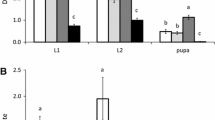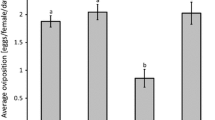Abstract
Two phytoseiid species, Euseius scutalis (Athias-Henriot) and Typhlodromips swirskii (Athias-Henriot), are able to suppress whitefly populations on single plants and are candidate biological control agents for whiteflies such as Bemisia tabaci (Gennadius). These species can feed on pollen and insect-produced honeydew and these food sources are likely to be available in crops. If the utilization of these food types results in increased reproduction or survival, populations of predators can persist when whitefly prey is scarce or absent. We studied the impact of pollen and whitefly-produced honeydew on the life history of the two phytoseiids. Cattail pollen allowed for survival, development and reproduction of both predators. Whitefly-produced honeydew greatly increased survival of E. scutalis, allowed for development into adulthood and for a sustained low rate of oviposition. The survival of adult T. swirskii was high on cucumber leaf tissue, either with or without pollen or honeydew. Oviposition by adults and juvenile survival of T. swirskii was very low in presence of honeydew. Biological control of whiteflies may benefit from both pollen and honeydew because these non-prey food sources have a positive effect on the life history of the two predator species, especially E. scutalis.
Similar content being viewed by others
References
Alomar O. and Wiedenmann R.N. (eds) 1996. Zoophytophagous Heteroptera: Implications for Life History and Integrated Pest Management. Thomas Say Publications, Entomological Society of America, Lanham, Maryland, 202 pp.
Bakker F.M. 1993. Selecting phytoseiid predators for biological control, with emphasis on the significance of tri-trophic interactions. Ph.D. Thesis, University of Amsterdam.
Coll M. 1998. Living and feeding on plants in predatory Heteroptera. In: Coll M. and Ruberson J.R. (eds) Predatory Heteroptera: Their Ecology and Use in Biological Control. Thomas Say Publications, Entomological Society of America, Lanham, Mayland. pp. 89–130.
Coll M. and Guershon M. 2002. Omnivory in terrestrial arthropods: mixing plant and prey diets. Annu. Rev. Entomol. 47: 267–297.
Costa H.S., Toscano N.C., Hendrix D.L. and Henneberry T.J. 1999. Patterns of honeydew droplet production by nymphal stages of Bemisia argentifolii (Homoptera: Aleyrodidae) and relative composition of honeydew sugars. J. Entomol. Sci. 34: 305–313.
Ferragut F., Garcia-Marí F., Costa-Comelles J. and Laborda R. 1987. Influence of food and temperature on development and oviposition of Euseius stipulatus and Typhlodromus phialatus (Acari: Phytoseiidae). Exp. Appl. Acarol. 3: 317–329.
Flechtmann C.H.W. and McMurtry J.A. 1992. Studies of cheliceral and deutosternal morphology of some Phytoseiidae (Acari: Mesostigmata) by scanning electron microscopy. Int. J. Acarol. 18: 163–169.
Hagen K.S. 1986. Ecosystem analysis: plant cultivars (HPR), entomophagous species and food supplements. In: Boethel D.J. and Eikenbarry R.D. (eds) Interaction of Plant Resistance and Parasitoids and Predators of Insects. John Wiley and Sons, New York, USA, pp. 151–197.
Hendrix D.L., Wei Y. and Leggett J.E. 1992. Homopteran honeydew sugar composition is determined by both the insect and plant species. Comp. Biochem. Physiol. 101: 23–27.
Hosmer D.W. and Lemeshow S. 1999. Applied Survival Analysis. Regression Modeling of Time to Event Data. John Wiley and Sons, Inc., New York, 386 pp.
Hulspas-Jordaan P.M. and van Lenteren J.C. 1978. The relationship between host-plant leaf structure and parasitization efficiency of the parasitic wasp Encarsia formosa Gahan (Hymenoptera: Aphelinidae). Mededel. Fac. Landbouwwet., Rijksuniv. Gent 43: 431–440.
Janssen A., Willemse E. and van der Hammen T. 2003. Poor host plant quality causes omnivore to consume eggs of its predator. J. Anim. Ecol. 72: 478–483.
Limburg D.D. and Rosenheim J.A. 2001. Extrafloral nectar consumption and its influence on survival and development of an omnivorous predator, larval Chrysoperla plorabunda (Neuroptera: Chrysopidae). Environ. Entomol. 30: 595–604.
McMurtry J.A. and Croft B.A. 1997. Life-styles of phytoseiid mites and their role in biological control. Annu. Rev. Entomol. 42: 291–321.
McMurtry J.A. and Rodriguez J.G. 1987. Nutritional ecology of phytoseiid mites. In: Slansky F. and Rodriguez J.G. (eds) Nutritional Ecology of Insects, Mites Spiders and Related Invertebrates. John Wiley and Son, New York, pp. 609–644.
McMurtry J.A. and Scriven G.T. 1964. Studies on feeding reproduction and development of Amblyseius hibisci (Acarina: Phytoseiidae) on various food substances. Ann. Entomol. Soc. Am. 57: 649–655.
Momen F.M. and El-Saway S.A. 1993. Biology and feeding behaviour of the predatory mite, Amblyseius swirskii (Acari: Phytoseiidae). Acarologia 34: 199–204.
Nomikou M., Janssen A., Schraag R. and Sabelis M.W. 2001. Phytoseiid predators as potential biological control agents for Bemisia tabaci. Exp. Appl. Acarol. 25: 270–290.
Nomikou M., Janssen A., Schraag R. and Sabelis M.W. 2002. Phytoseiid predators suppress populations of Bemisia tabaci on cucumber plants with alternative food. Exp. Appl. Acarol. 27: 57–68.
Nomikou M., Janssen A., Schraag R. and Sabelis M.W. Vulnerability of Bemisia tabaci immatures to phytoseiid predators: consequences for oviposition and influence of alternative food (in prep. a).
Nomikou M., Janssen A. and Sabelis M.W. Impact of alternative food on the dynamics of predatory mites, Typhlodromips swirskii, and their whitefly prey (in prep. b).
Overmeer W.P.J. 1985a. Alternative prey and other food resources. In: Helle W. and Sabelis M.W. (eds) Spider Mites, Their Biology, Natural Enemies and Control. Vol. 1b. Elsevier, Amsterdam, pp. 131–139.
Overmeer W.P.J. 1985a. Rearing and handling. In: Spider Mites, Their Biology, Natural Enemies and Control. Vol. 1b. Helle W. and Sabelis M.W. (eds) Elsevier, Amsterdam, pp. 162–170.
Polis G.A. and Winemiller K.O. 1996. Food Webs. Integration of Patterns and Dynamics. Chapman and Hall, New York.
Polis G.A., Myers C.A. and Holt R.D. 1989. The ecology and evolution of intraguild predation: potential competitors that eat each other. Ann. Rev. Ecol. Syst. 20: 297–330
Ragusa S. and Swirski E. 1977. Feeding habits, post-embryonic and adult survival, mating, virility and fecundity of the predacious mite Amblyseius swirskii (Acarina: Phytoseiidae) on some coccids and mealybugs. Entomophaga 22: 383–392.
Rosenheim J.A., Kaya H.K., Ehler L.E., Marois J.J. and Jaffee B.A. 1995. Intraguild predation among biological-control agents: theory and evidence. Biol. Control 5: 303–335
Sabelis M.W. 1990. How to analyse prey preference when prey density varies? A new method to discriminate between effects of gut fullness and prey type composition. Oecologia 82: 289–298.
Salas-Aguilar J. and Ehler L.E. 1977. Feeding habits of Orius tristicolor. Ann. Entomol. Soc. Am. 70: 60–62.
Siegel S. and Castellan N.J. 1988. Non-parametric Statistics for the Behavioural Sciences. 2nd edn. McGraw-Hill International Editions, New York.
Sokal R.R. and Rohlf F.J. 1995. Biometry. 3rd edn. Freeman, New York.
Stoner A. 1970. Plant feeding by a predaceous insect, Geocoris punctipes. J. Econ. Entomol. 63: 1911–1915.
Swirski E., Amitai S. and Dorzia N. 1967. Laboratory studies on the feeding, development and reproduction of the predaceous mites Amblyseius rubini Swirski and Amitai and Amblyseius swirskii Athias-Henriot (Acarina: Phytoseiidae) on various kind of food substances. Israel J. Agric. Res. 17: 101–119.
van Rijn P.C.J., van Houten Y.M. and Sabelis M.W. 2002. How plants benefit from providing food to predators even when it is also edible to herbivores. Ecology 88: 2664–2679.
van Rijn P.C.J. and Tanigoshi L.K. 1999a. Pollen as food for the predatory mites Iphiseius degenerans and Neoseiulus cucumeris (Acari: Phytoseiidae): dietary range and life history. Exp. Appl. Acarol. 23: 785–802.
van Rijn P.C.J. and Tanigoshi L.K. 1999b. The contribution of extrafloral nectar to survival and reproduction of the predatory mite Iphiseius degenerans on Ricinus communis. Exp. Appl. Acarol. 23: 281–296.
Zemek R. and Prenerová E. 1997. Powdery mildew (Ascomycotina: Erysiphales)-an alternative food for the predatory mite Typhlodromus pyri Scheuten (Acari: Phytoseiidae). Exp. Appl. Acarol. 21: 405–414.
Zhimo Z. and McMurtry J.A. 1990. Development and reproduction of three Euseius (Acari: Phytoseiidae) species in the presence and absence of supplementary foods. Exp. Appl. Acarol. 8: 233–242.
Author information
Authors and Affiliations
Corresponding author
Rights and permissions
About this article
Cite this article
Nomikou, M., Janssen, A. & Sabelis, M.W. Phytoseiid predators of whiteflies feed and reproduce on non-prey food sources. Exp Appl Acarol 31, 15–26 (2003). https://doi.org/10.1023/B:APPA.0000005142.31959.e8
Issue Date:
DOI: https://doi.org/10.1023/B:APPA.0000005142.31959.e8




